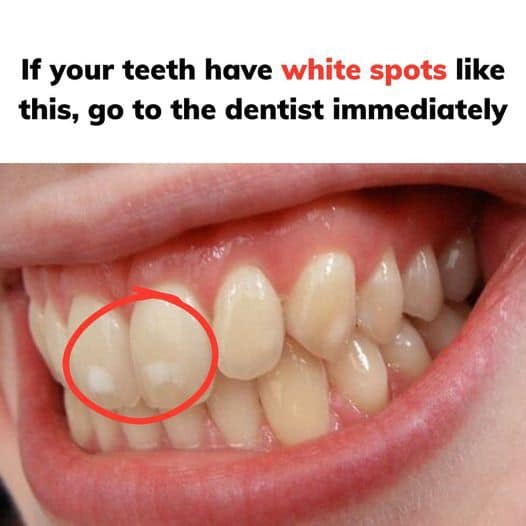ADVERTISEMENT
**If Your Teeth Have White Spots Like This, Go to the Dentist Immediately: Here’s Why**
White spots on your teeth can be alarming, and they often signify underlying dental issues that need attention. While teeth with a natural shine and smooth surface are ideal, those with white spots are a signal that something may be wrong. These spots are often an early warning sign of tooth decay, enamel demineralization, or other dental concerns.
If you notice white spots on your teeth, it’s important to understand the potential causes and take the necessary steps to address them, which often includes visiting a dentist as soon as possible. Here’s why white spots appear on teeth and what you should do about it.
—
### **What Are White Spots on Teeth?**
White spots on teeth are areas where the enamel (the outer layer of the tooth) has lost minerals, causing it to become porous and appear lighter in color. These spots can vary in size and shape and are typically visible on the front teeth, though they can appear on any tooth.
In some cases, white spots can look like small dots or streaks, while in others, they may form larger patches. Although they don’t always cause pain, they can be a sign of more serious dental issues.
—
### **Common Causes of White Spots on Teeth**
There are several reasons why white spots may develop on your teeth, and identifying the cause is crucial for determining the best course of action.
#### **1. Enamel Demineralization (Early Tooth Decay)**
One of the most common reasons for white spots on teeth is demineralization of the enamel. This process occurs when acids from food, beverages, or bacteria in the mouth begin to strip minerals from the enamel, leaving it weak and prone to further decay. Early tooth decay often presents itself in the form of these white spots.
If demineralization is caught early enough, it’s possible to reverse the process by improving your oral hygiene and using fluoride treatments. However, if the decay progresses, it could lead to cavities and tooth sensitivity.
#### **2. Fluorosis (Excessive Fluoride Exposure)**
Fluorosis occurs when a child consumes too much fluoride while their teeth are still developing. This can happen if a child swallows fluoride toothpaste or drinks water with high fluoride levels. Fluorosis typically leads to white spots or streaks on the teeth. While fluorosis is generally not harmful to the teeth, it can cause cosmetic issues that may need to be addressed by a dentist.
#### **3. Poor Oral Hygiene**
Inadequate brushing and flossing can allow plaque and bacteria to accumulate on the teeth, leading to white spots. Poor oral hygiene is a key contributor to enamel demineralization and decay. Without proper care, plaque buildup can harden into tartar, which can worsen the appearance of white spots and lead to further damage.
Regular cleaning and maintaining good oral hygiene are essential in preventing these issues.
#### **4. Diet and Acidic Foods**
A diet rich in sugary, acidic, or processed foods can contribute to the formation of white spots. Acidic foods (like citrus fruits and soda) and sugary snacks encourage bacteria to produce acids that weaken tooth enamel, leading to demineralization.
It’s important to balance your diet by eating foods that promote healthy teeth, such as vegetables, cheese, and other dairy products.
#### **5. Teeth Whitening Products**
Some over-the-counter teeth whitening products can lead to temporary white spots on the teeth. These products can remove surface stains, but if used too frequently or improperly, they may strip away enamel, leaving teeth looking unevenly white.
For Complete Cooking STEPS Please Head On Over To Next Page Or Open button (>) and don’t forget to SHARE with your Facebook friends
ADVERTISEMENT
